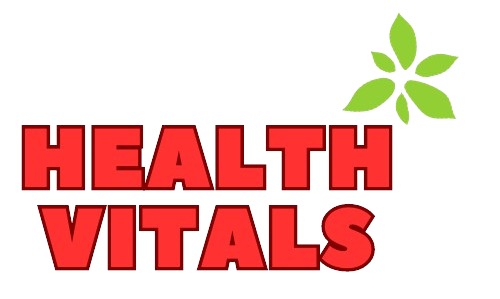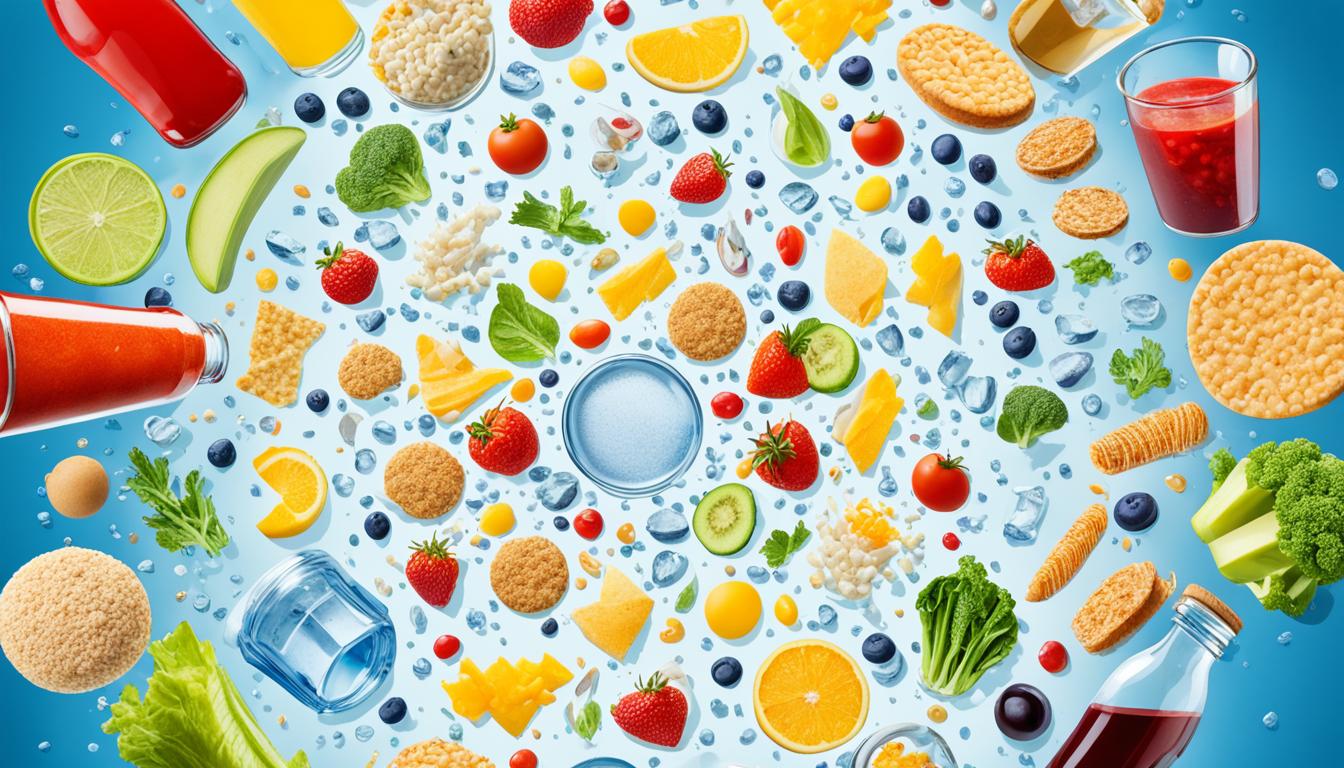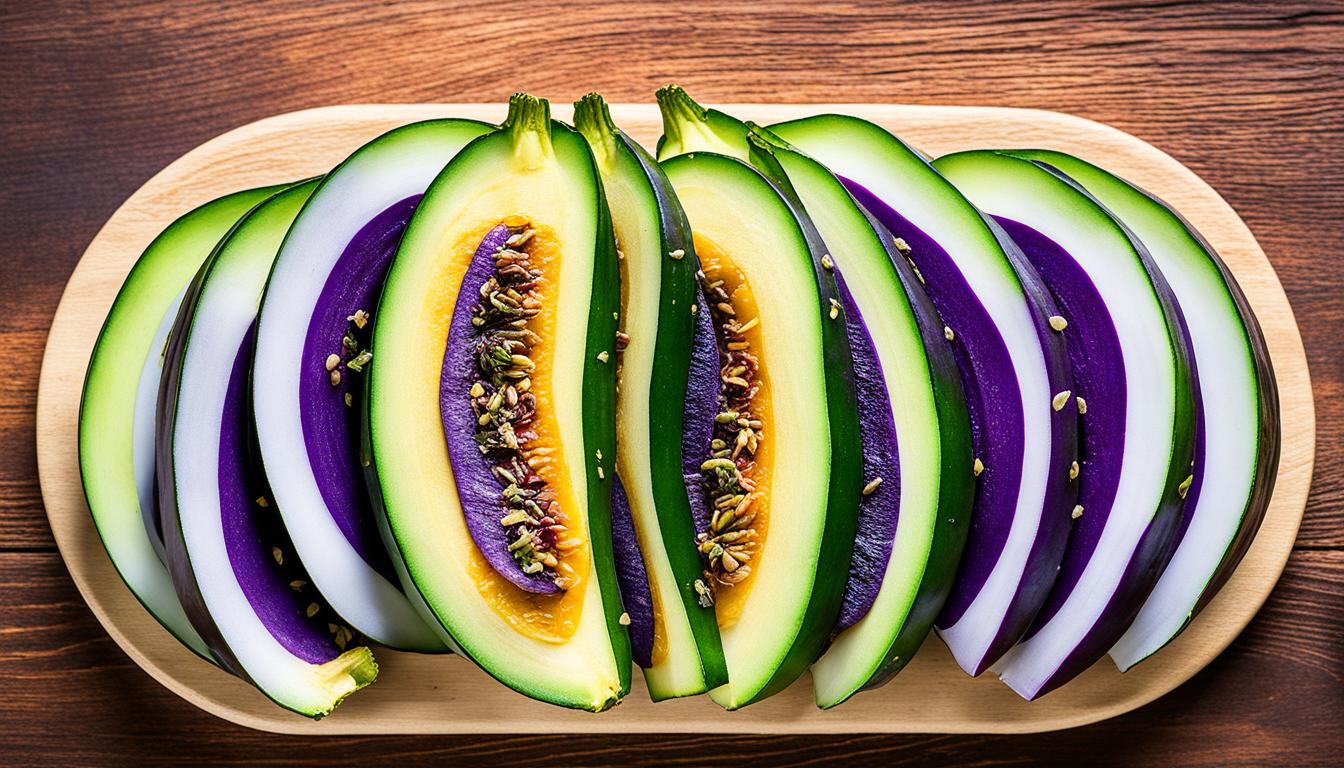About 90% of adults in the United States will get high blood pressure in their lives. This fact shows how important it is to know about the salt we eat. While our bodies need sodium, most Americans eat too much. This leads to health problems like heart disease and stroke.
More than 70% of the sodium we eat comes from packaged and processed foods. This is different from what many think. Often, we blame the salt shaker. This article dives into the complex role of sodium in our diet. It will share facts and tips to help us make better choices about sodium.
Key Takeaways
- The majority of dietary sodium comes from packaged and processed foods, not from table salt.
- About 90% of adults in the U.S. are expected to develop high blood pressure over their lifetimes.
- The average daily sodium consumption in the U.S. is about 3,400 mg, exceeding the recommended limit of 2,300 mg.
- Reducing sodium intake can significantly decrease the risk of high blood pressure and cardiovascular disease.
- Understanding the sources of sodium and reading nutrition labels are key to making informed dietary choices.
The Importance of Understanding Dietary Sodium
Sodium is vital for our bodies in small doses. It helps with fluid, nerve, and muscle function. But, many Americans eat more than they should. They take in around 3,400 mg each day. This is above the recommended 2,300 mg. Such high intake can lead to health problems like high blood pressure, stroke, and heart disease.
Sodium: An Essential Nutrient with Potential Health Risks
Our body needs sodium for health. But too much can be harmful. It can make the blood volume increase, raising blood pressure. This can lead to issues like heart diseases, stomach cancer, and more. So, it’s important to watch our sodium intake to stay healthy.
The Prevalence of High Sodium Consumption in the American Diet
Many get most of their sodium from packaged foods. This surprises some, as they think table salt is the main source. Knowing this helps people make better food choices. By understanding where sodium comes from, we can avoid health problems.
Busting the Myths: Where Does Our Sodium Come From?
Many think adding salt is the main way we get too much sodium. But, the truth is, most of the sodium we eat in America is from packaged and processed foods. It isn’t mainly coming from the salt shaker when we cook or at the dinner table.
The Surprising Reality: Packaged and Processed Foods as Major Contributors
Surprisingly, foods we might not see as salty, like bread, cereal, and some meats, can be packed with sodium content. This makes it very important to check food labels and understand where the hidden sodium is in our food. It’s not just in obvious snacks like chips or canned soups.
Beyond the Salt Shaker: Hidden Sources of Sodium in Common Foods
Ingredients like monosodium glutamate (MSG), sea salt, and sodium chloride are common in our daily foods. Even if a food doesn’t taste salty, it can contain a lot of dietery sodium. This shows why we need to watch our sodium intake and work on reducing it.
The Role of Sodium in Blood Pressure and Cardiovascular Health
There’s a strong link between eating too much sodium and high blood pressure. Sodium makes the body hold onto water. So, eating too much salt can make your blood volume go up. This leads to high blood pressure. If not controlled, high blood pressure can cause heart attacks, heart failure, strokes, kidney disease, and more.
Understanding the Link Between Sodium Intake and Hypertension
In 2014, Whelton P.K. and He J. looked into the effects of sodium and potassium on people. They found that sodium plays a big part in controlling blood pressure. He F.J. and MacGregor G.A., in 2002, showed that cutting back a little on salt can lower blood pressure. This shows how important it is to keep a steady salt intake.
The Importance of Maintaining a Balanced Sodium Level
Keeping a balanced sodium level is key. Too much or too little sodium is bad for your heart. Graudal N. et al., in 2014, found that diets with very low or very high sodium can lead to more deaths. This research shows how crucial it is to find the right sodium balance.
It’s critical to understand how salt affects your heart health. This knowledge helps you make smart choices about how much salt you eat. This way, you can work to keep your heart healthy.
Dietary Sodium and Individual Differences
Studies show that how our bodies react to sodium can vary a lot. Only around a quarter of people might see their blood pressure jump with more salt. Things like your genes and how old, heavy, or male/female you are matter. There’s no easy test for finding out who’s salt sensitive, yet. But knowing these differences can help doctors and us figure out the best ways to handle salt and keep our hearts healthy.
Identifying Salt Sensitivity: Genetic and Risk Factors
Your genes and a bunch of other things affect how you handle salt. Some people’s blood pressure can soar with more salt, thanks to specific genes. Also, how old you are, your gender, and your weight can all matter. This info helps doctors and people put together plans for dealing with dietary sodium and keeping our hearts in good shape.
Right now, there isn’t a quick, easy way to find out if someone is salt sensitive. But it’s key to think about our personal risks and differences. By being aware of these, doctors and we can find the right ways to deal with dietary sodium. That way, we can stay healthy by watching our salt, even without a simple test.
The Enigma of Salt Storage: Unveiling New Discoveries
The way our bodies deal with sodium from food is not as simple as we thought. The Mars500 study looked closely at how much sodium was taken in and then put out. It found a big surprise – our bodies weren’t just getting rid of extra sodium, they were keeping some too.
Challenging Conventional Wisdom: The Mars500 Study
The study’s findings show us that how salt and water work together is really complex. This means we need to do more research. We want to know exactly how our bodies handle sodium. This could tell us a lot about staying healthy as we get older.
Exploring the Role of Salt in Hydration and Aging
Getting older makes it essential for our bodies to keep sodium and water in balance. New clues suggest that salt is key for staying well-hydrated and keeping our cells healthy. These findings shake up the idea that cutting back on sodium is the only way. They point us towards looking deeper into the effects of salt on our health and coming up with diets that are right for each person.
Navigating the Nutrition Facts Label for Sodium Control
The Nutrition Facts label is key for those watching their sodium. It’s a tool required by the U.S. FDA. It tells us how much sodium is in our food, helping us choose healthier options.
Understanding Daily Values and Percentage Daily Values
The label shows the Daily Value (DV) for sodium is less than 2,300 mg a day. High sodium can lead to health problems like high blood pressure. This guideline is for everyone’s well-being.
Look at the Percent Daily Value (%DV) to see if food is high or low in sodium. Foods with less than 5% DV are low, and 20% or more is high. Knowing this helps people keep their sodium intake low, keeping their heart healthy.low-sodium diet and support their overall heart health.
Paying Attention to Serving Sizes and Comparing Products
Serving sizes are important when reading the Nutrition Facts. The sodium you see is per serving. But it might not be the full amount you eat. Always look at size info to pick healthier foods.
Knowing how to read a Nutrition Facts label is crucial for your health. It helps you manage your sodium intake better. This can lower your chance of high blood pressure and heart problems.dietary sodium intake, making choices that support their overall health and well-being. This knowledge can empower individuals to effectively manage their sodium consumption and reduce their risk of developing high blood pressure and other cardiovascular health issues.
Low-Sodium Eating: Tips and Strategies
Reducing sodium in your diet is very important for good health. It helps manage high blood pressure and keeps your heart healthy. There are many easy tips to eat less salt and have a balanced diet without too much sodium.
Preparing Meals at Home and Limiting Processed Foods
Making your own meals is a great way to cut down on sodium. Most of the salt in our diets comes from packaged and processed foods. When you cook at home, you can choose what goes into your food, making it much healthier.
Choosing Low-Sodium Alternatives and Flavor Boosters
Always try to pick foods that are low in salt. Look for items with 5% Daily Value (DV) or less of sodium. Foods with 20% DV or more are too high. You can also use herbs, spices, and other tasty ingredients to make your food flavorful without salt.
Making Informed Choices When Dining Out
Eating out means you can’t always control how much salt is in your food. But, you can still be smart about it. Ask for dishes to be made without extra salt. Choose smaller servings, and get your sauces and dressings on the side. This way, you can watch your sodium intake even when you’re not at home.
Surprising Sources of Sodium
When we think about sodium, the salt shaker is often the first thing we consider. But, most of the sodium Americans eat actually comes from unexpected places. Many foods we don’t think of as salty can add a lot of sodium to our diet.
Soups, Breads, and Condiments: Hidden Sodium Bombs
Soups are a big surprise when it comes to sodium, with some containing 800-1,000 mg per serving. Breads are another stealthy source, adding between 100 and 200 mg per slice. Don’t forget condiments – ketchup sneaks in 150 mg of sodium per teaspoon. And soy sauce has around 900 mg of sodium in just one tablespoon. It’s a strong reminder to always check the nutrition content on food labels.
Meats, Cheeses, and Nuts: Unexpected Sodium Culprits
Protein-rich foods also hide a lot of sodium. Lunch meats, for example, can have over 400 mg of sodium in a single slice. Cheddar cheese and potato chips match up in sodium content ounce per ounce. Even nuts, often seen as a healthy snack, can be high in sodium if they’re salted. This shows why it’s crucial to carefully read labels and steer clear of sodium-heavy options.
dietery sodium: Finding the Right Balance
Finding the right balance in dietary sodium is important. Too much can lead to bad health like high blood pressure. But too little may not be good either. It’s vital to find the right amount to stay healthy.
The “Sweet Spot” for Sodium Intake: Avoiding Extremes
Knowing the ideal sodium intake is crucial. We should not have too much or too little. Aim for a balanced level. Experts usually say to keep sodium below 2,300 mg a day. Those at high risk should aim for 1,500 mg daily.
Tailoring Sodium Recommendations to Individual Needs
Everyone’s sodium needs are different. Things like genes, age, and health affect how much we should have. Some people are more affected by sodium. Others need more for their body to work well. It’s all about finding what works best for you.
Understand these guidelines to make smarter sodium choices. This way, we support a healthier life. Remember to balance, stay away from the extremes, and adjust sodium in your diet. This promotes better health and lifestyle.
The Ongoing Scientific Debate: Salt and Health
The debate about salt’s impact on health is far from over. While we often hear that eating too much salt can lead to health issues like high blood pressure, not all studies agree. Some research challenges this common belief.
Conflicting Studies and Evolving Research
Why is this issue so complex? It’s because people react to salt differently, and our bodies handle salt in various ways. Because of these differences, there isn’t a one-size-fits-all answer.
Recent studies suggest there might be a sweet spot for how much salt we should eat. This ideal amount doesn’t always match the strict limits health experts advise. So, the science is still changing.
The Need for Personalized Nutritional Approaches
With evidence pointing in different directions, personalized nutrition is crucial. It’s key to consider each person’s health needs and the latest findings. This means it’s vital to keep up with new research and keep an open mind.
Staying informed is crucial as we learn more about salt’s effects on our health. Topics like eating less salt, managing high blood pressure, choosing the right foods, and finding salt substitutes all play a part in better heart health.
FAQ
What is the role of dietary sodium in the American diet?
Where does most of the sodium in the American diet come from?
How does excessive sodium intake affect blood pressure and cardiovascular health?
Are all individuals equally sensitive to dietary sodium?
What new discoveries are challenging the traditional understanding of how the body handles sodium?
How can the Nutrition Facts label help individuals control their sodium intake?
What practical tips can help reduce sodium intake?
What are some surprising sources of sodium in the American diet?
What is the “sweet spot” for dietary sodium intake, and why is it important?
How is the scientific understanding of the relationship between salt and health continuing to evolve?
Source Links
- https://www.ncbi.nlm.nih.gov/pmc/articles/PMC8033889/
- https://www.heart.org/en/healthy-living/healthy-eating/eat-smart/sodium/sodium-and-salt
- https://www.fda.gov/food/nutrition-education-resources-materials/sodium-your-diet
- https://www.who.int/news-room/fact-sheets/detail/salt-reduction
- https://www.ncbi.nlm.nih.gov/pmc/articles/PMC5098396/
- https://www.heart.org/en/healthy-living/healthy-eating/eat-smart/sodium/sodium-sources
- https://www.texashealth.org/-/media/Project/THR/shared/Documents/PDFs/Health-and-Wellness/Heart-and-Vascular/Salty-Myths.pdf
- https://www.ncbi.nlm.nih.gov/pmc/articles/PMC6770596/
- https://www.ncbi.nlm.nih.gov/pmc/articles/PMC7321755/
- https://www.ncbi.nlm.nih.gov/pmc/articles/PMC7012692/
- https://www.chemeurope.com/en/news/1179278/simulations-and-experiments-reveal-unprecedented-detail-about-waters-motion-in-salt-water.html
- https://www.ncbi.nlm.nih.gov/pmc/articles/PMC2909369/
- https://www.frontiersin.org/articles/10.3389/fmmed.2021.777088/pdf
- https://diabetes.org/food-nutrition/reading-food-labels/making-sense-food-labels
- https://health.gov/myhealthfinder/health-conditions/heart-health/eat-less-sodium-quick-tips
- https://www.nhlbi.nih.gov/news/2023/halt-salt-5-ways-cut-down-sodium-and-improve-your-heart-health
- https://www.gundersenhealth.org/health-wellness/eat-move/8-surprising-sources-of-sodium
- https://www.healthline.com/nutrition/foods-high-in-sodium
- https://www.news-medical.net/news/20240409/The-global-quest-for-the-right-balance-of-sodium-and-potassium-in-the-diet.aspx
- https://www.ncbi.nlm.nih.gov/pmc/articles/PMC4312143/
- https://pubmed.ncbi.nlm.nih.gov/25659992/
- https://www.todaysdietitian.com/newarchives/tdaug2007pg40.shtml




